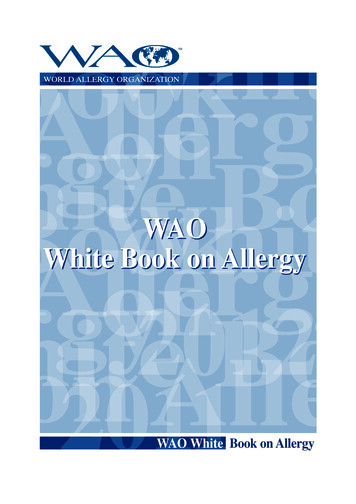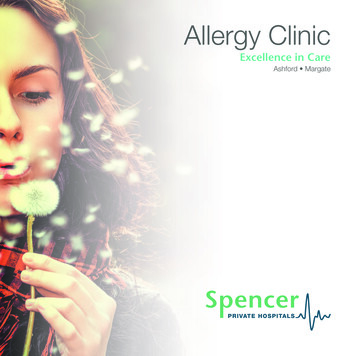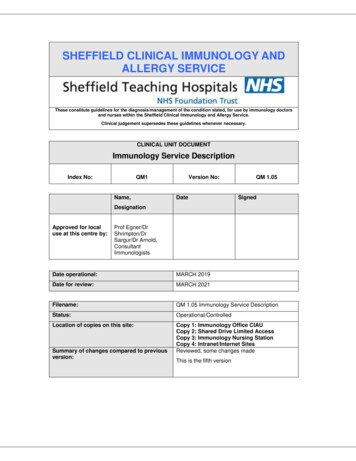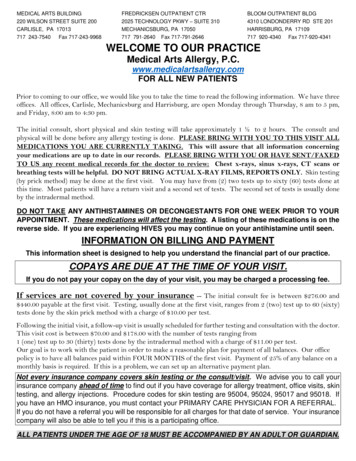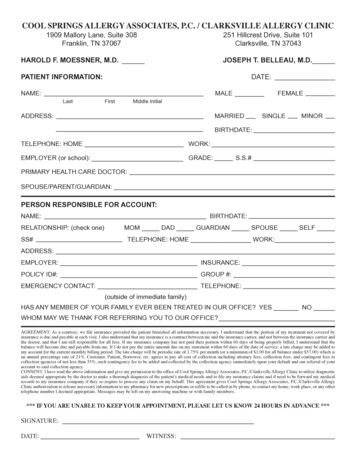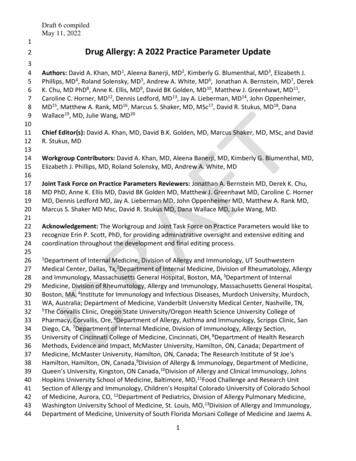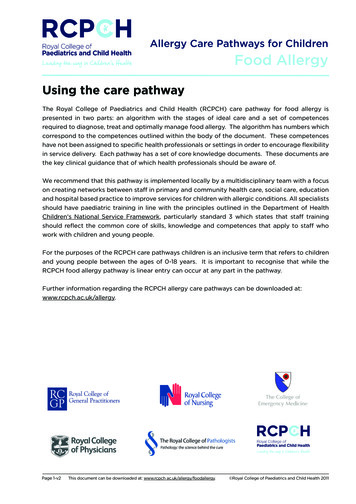
Transcription
Allergy Care Pathways for ChildrenFood AllergyUsing the care pathwayThe Royal College of Paediatrics and Child Health (RCPCH) care pathway for food allergy ispresented in two parts: an algorithm with the stages of ideal care and a set of competencesrequired to diagnose, treat and optimally manage food allergy. The algorithm has numbers whichcorrespond to the competences outlined within the body of the document. These competenceshave not been assigned to specific health professionals or settings in order to encourage flexibilityin service delivery. Each pathway has a set of core knowledge documents. These documents arethe key clinical guidance that of which health professionals should be aware of.We recommend that this pathway is implemented locally by a multidisciplinary team with a focuson creating networks between staff in primary and community health care, social care, educationand hospital based practice to improve services for children with allergic conditions. All specialistsshould have paediatric training in line with the principles outlined in the Department of HealthChildren's National Service Framework, particularly standard 3 which states that staff trainingshould reflect the common core of skills, knowledge and competences that apply to staff whowork with children and young people.For the purposes of the RCPCH care pathways children is an inclusive term that refers to childrenand young people between the ages of 0-18 years. It is important to recognise that while theRCPCH food allergy pathway is linear entry can occur at any part in the pathway.Further information regarding the RCPCH allergy care pathways can be downloaded at:www.rcpch.ac.uk/allergy.Page 1-v2This document can be downloaded at: www.rcpch ac.uk/allergy/foodallergy. Royal College of Paediatrics and Child Health 2011
Entry pointsAcute PresentationAnaphylaxisNon Acute Presentationscutaneous, gastrointestinal symptoms, upper or lowerrespiratory symptoms, faltering growth, severe aversivefeeding, parental suspicion of food allergyAcute Presentation(non anaphylactic acute ected adversereactions (1)ConfirmedDiagnosisi. Recognition of possible role of foods in a broad spectrum of presentationsii. Understanding of major categories of adverse reactions to food including toxic reactions, foodallergy, food intolerance and food aversion and their differentiating featuresiii. Recognition of risk factors for allergic aetiology to presenting featuresiv. Refer onwards, as appropriatei. History is paramount - allergy focused clinical history and examination (2)ii. Investigations tailored to suspected underlying mechanism (3-5)Immediate/acute reactions: skin prick/specific IgE testingDelayed/non acute reactions: elimination/challengeOther investigations dependant on specific concern: e.g endoscopy, biopsy, otherimmunological studiesAdverse reactions to food with no underlyingallergic componente.g. lactose intoleranceDefinitive management or refer toappropriate servicesConsiderEczema and/or Urticaria PathwaySelf care (6)i. Recognise that the child has food allergyii. Careful allergen avoidanceiii. Adherence to personal management planiv. Seek appropriate professional adviseManagementStandard managementi. Allergy specific advice (7)ii. Optimisation of prevention and treatment of further reactions - written personalmanagement plan/training (8)iii. Minimising impact on quality of life (9)iv. Nutritional support and monitoring by registered dietitian (10)v. Management of co-morbidities (11)vi. Additional patient/carer support (12)vii. Communication with other agencies (13)viii. Onward referral and liaison, if required (14)ix. Further care, as detailed below (see 8, 9, 16-20)Complex Management (MDT setting) (15)i. Involvement of clinical nurse specialist in paediatric allergy (15)ii. Involvement/referral to allied healthcare professionals, ideally in joint allergy clinicse.g. specialist paediatric allergy dietitian (15)iii. Expert psychosocial support (15)iv. Further care, as detailed below (see 8, 9, 16-20)OngoingManagementNotes:Page 3-v2i.ii.iii.iv.Optimisation of the prevention, recognition and treatment of further reactions (8)Minimising impact on quality of life (9)Regular appropriate monitoring of growth and nutrition (16)Recognise the resolution of food allergy (tolerance) supported by allergy test and, ifindicated rechallenge (17)v. Identification and management of emerging co-morbidities (18)vi. Revision of personal management plan (19)vii. Communication and managed transition (20)1. The colours on the pathway and competence table correspond to the modified Scottish Intercollegiate Guidelines Network SIGN grade:GRADE AGRADE BGRADE CGRADE DCLINICAL PRACTICE GUIDELINEGOOD PRACTICE POINT2. The numbers on the pathway correspond to the competences required to provide care - these are on the following pages3. documentLinks to thecanreferencescan be foundwithin the competencestatementsThisbe downloadedat: www.rcpchac.uk/allergy/foodallergy. Royal College of Paediatrics and Child Health 2011
Food allergy definitionFood Allergy is defined as an immune-mediated hypersensitivity reaction to food and may bedivided into Immunoglobulin E (IgE) mediated (immediate-onset) reactions and non IgE-mediated(delayed-onset) reactions (21).Core knowledge documentThe core knowledge document for the food allergy pathways is:§ NICE guideline for the diagnosis and assessment of food allergy in children and youngpeople in primary care and community settings (22)CompetenceRefPathway stageCompetence1Initial recognition/suspected adversereactions to foodKnow the major categories include adverse reactions to food includingtoxic reactions (food poisoning), food allergy (IgE and non IgE),food intolerance (enzymatic, pharmacological and other) andfood aversion that food allergy may present in a variety of ways ranging fromimmediate allergic reactions to more chronic presentations suchas eczema or gastrointestinal (GI) symptoms (22) that many common childhood conditions such as eczema,gastro oesophageal reflux (GOR), diarrhoea, constipation,faltering growth may have an allergic aetiology (22) that food allergy is more common in children with early onset,moderate/severe eczema (23) that oral pharyngeal reactions to food may be the result ofcross-reactivity with pollen allergens (pollen-fruit syndrome) orlatex (latex-fruit syndrome)Be able to recognise that food allergy may present in a variety of waysranging from immediate allergic reactions to more chronicpresentations such as eczema or GI symptoms (22) recognise the risk factors for allergic aetiology of presentingfeatures such as family or personal history of atopy differentiate different types of adverse reactions to food basedon findings from history and examination refer onwards, as appropriatePage 3-v2This document can be downloaded at: www.rcpch ac.uk/allergy/foodallergy. Royal College of Paediatrics and Child Health 2011
2Confirmeddiagnosis – historyis paramount –allergy focusedclinical history andexaminationKnow the common foods which are responsible for most foodallergies, their relative prevalence in different presentations(e.g. mechanism, age, ethnicity) and their relevant cross and coreactivitiesBe able to take and interpret an allergy focused clinical history (22, 24-28)and perform relevant examination(s) differentiate different types of adverse reactions to food basedon findings from history and examination recognise and distinguish the features of anaphylaxis from lesssevere allergic reactions to food recognise the clinical features of conditions which masqueradeas adverse reactions to food (e.g. viral urticaria, infectiousgastroenteritis) gather information on relevant exposures to other potential foodallergens and take a dietary history including the interpretationof a food and symptom diary recognise the possible role of co-factors to allergic reactions tofood e.g. exercise, infection and alcohol take a full history relating to important co-morbidities (e.g.asthma, eczema, allergic rhinitis) and psychosocial issues andinterpret the findings examine and interpret findings in relevant body systemsincluding accurate anthropometry, GI, chest, ENT and skin to use a clinical history, followed by appropriate investigations to identify oral allergy syndrome and differentiate primary foodallergies from those caused by cross reactivity with pollensPage 5-v24-v2This document can be downloaded at: www.rcpch ac.uk/allergy/foodallergy. Royal College of Paediatrics and Child Health 2011
3Confirmeddiagnosis –Investigationstailored tosuspectedunderlyingmechanism – forsuspected IgEmediated allergiesHave access to appropriate facilities, practical skill and knowledge toundertake and interpret investigations including– skin prick testing (SPT) (22) – serum specific IgE testing (22) – medically supervised oral challenges in a safe and controlled environment with facility for paediatric resuscitation (27, 29,30) and advanced life support appropriate quality control through guidelines and standardoperating procedures to ensure the clinical competence of staffconducting SPT and oral food challenges access to an appropriately accredited laboratory for specific IgEtestingKnow which oral challenges may be done as open rather than doubleblind, placebo controlled, which require medical supervision andwhich are suitable for home (with appropriate guidance) which allergies may occur together in the same individual (24,29) (e.g. peanut and sesame allergies) and therefore whichadditional tests to consider that the level of specific IgE varies and should not be used inplace of oral food challenges to determine allergy (e.g. cowsmilk allergy) (31) that complementary and alternative medicine (CAM) allergytests, including kinesiology, serum specific IgG and Vega testshave no place in the diagnosis and/or management of foodallergy (22)Understand the difference between sensitisation to food allergens and clinicalallergy performance (sensitivity and specificity) of tests forsensitisation to foods allergensBe able to Perform an appropriate panel of tests, including– skin prick testing (SPT) (24, 30, 32-36) – serum specific IgE testing (24, 27, 30, 35) interpret the results of investigations in the context of theclinical history (24, 34)Page 5-v2This document can be downloaded at: www.rcpch ac.uk/allergy/foodallergy. Royal College of Paediatrics and Child Health 2011
45Confirmeddiagnosis –investigationstailored tosuspectedunderlyingmechanism – forsuspected non IgEmediated allergiesHave access to appropriate facilities, practical skill and knowledgeto undertake and interpret food exclusions and reintroductions(29) (with adequate dietetic supervision) access to tests for IgE mediated allergy for purposes ofexclusion, if appropriateConfirmeddiagnosis –Investigationstailored tosuspectedunderlyingmechanism – otherHave access or pathway for referral to a centre with appropriatefacilities, practical skill and knowledge to undertake andinterpret diagnostic GI endoscopies and biopsies.Know that SPT and serum specific IgE test have a poor predictivevalue for non IgE mediated allergies that atopy patch tests are available but that their role in thediagnosis of food allergy remains unclear (24, 36) that complementary and alternative medicine (CAM) allergytests, including kinesiology, serum specific IgG and Vega testshave no place in the diagnosis and/or management of foodallergy (22)Know that complementary and alternative medicine (CAM) allergytests, including kinesiology, serum specific IgG and Vega testshave no place in the diagnosis and/or management of foodallergy (22)Be able to recognise where further tests may be required in order toconfirm diagnosis6Management – selfcareKnow when to seek health professional advice which foods and/or allergens to avoidBe able to recognise that the child has food allergy follow an agreed personal management plan7Management– standardmanagement:allergy specificadviceKnow what foods (including catering, manufactured ingredients andmanufactured foods) are likely to contain trigger foods clinically relevant cross-reactivities (29) and co-reactivitiesBe able to advise on appropriate dietary exclusion and alternativesincluding practical, individualised advice (29, 31, 35, 37, 38) (e.gcultural and age appropriate advice) advise on appropriate avoidance of non food triggers (e.g.cosmetics and toiletries)Page 7-v26-v2This document can be downloaded at: www.rcpch ac.uk/allergy/foodallergy. Royal College of Paediatrics and Child Health 2011
8Management– standardmanagement:optimisation ofprevention andtreatment offurther reactions,including personalmanagement planKnow common situations when allergen exposure is most likely tooccur (e.g. eating out) risk factors for severe allergic reactions (e.g. poorly controlledasthma, adolescence) which children require which emergency medications (29, 3942) e.g. antihistamines, adrenaline injectors the EAACI position statement with regards to the absolute andrelative indications for the prescription of injectable adrenaline(41) the risks inherent to specific situations (e.g. home, school,eating out and hospital settings)Be able to train/educate patients, parents and carers (23, 29, 39, 41, 4348) about effective food allergen avoidance, recognition andtreatment of reactions and their prevention advise patients, parents and carers with regards to riskassessment, to allow them to minimise the impact of allergenavoidance on day to day activities advise patients, parents and carers of the issues relating to riskin specific situations such (e.g. school and hospital catering) educate patients, parents and carers about high risk situations(e.g. eating out) and effective risk assessment, particularly foryoung persons provide emergency medication (including training) and anagreed written personal management plan (40-43, 47-50), asappropriate and according to a risk assessment strategy9ManagementKnow– standard how food allergy may impact on different aspects of daily life ofmanagement:the patient and family (46, 48, 53)minimising impact what resources are available locally and nationally to supporton quality of life (51,patients and their families52)Be able to provide support to patients and their families to helpminimise the impact of food allergy on quality of life througheducation, ongoing access for patient queries provide details of resources including patient charities, websitesand local support groups as well as psychosocial support ifrequired10Page 7-v2Management– standardmanagement:nutritional supportand monitoring (28,29, 35, 38)Know appropriate nutritional requirements for children at differentagesBe able to ensure nutritional sufficiency in the context of dietaryrestrictions during different stages of childhoodThis document can be downloaded at: www.rcpch ac.uk/allergy/foodallergy. Royal College of Paediatrics and Child Health 2011
11Management– standardmanagement:management of comorbidities (23, 25,35)Know the patterns of disease progression in children with food allergy the signs and symptoms of co-morbid conditions the impact of different allergic co-morbidities on each other(e.g. asthma on food allergy, food allergy on eczema)Be able to identify and treat co-morbidities as part of an holistic,individualised approach12Management– standardmanagement:additional patient/carer supportKnow the different routes available for patient support e.g.Anaphylaxis Campaign (54), National Eczema Society (55), TheEosinophilic Disease Society (56), Latex Allergy Support Group(57), Living with Reflux (58), Food Standards Agency (59)Be able to provide written information about food allergy provide details of how to contact patient support groups13ManagementBe able to– standard communicate effectively with patients, parents and carers,management:primary care, other health care professionals, schools and earlycommunication withyears settings (SEYS) (29) and where necessary social servicesother agencies share appropriate information to support other health careprofessionals in performing a risk assessment14Management– standardmanagement:onward referral andliaisonKnow when to refer to other agencies, e.g. CAMHS as requiredManagement– complexmanagementKnow that complex management of patients is best provided by amultidisciplinary team (35, 43, 48) including paediatric-trained,allergy specialist doctor(s), nurse(s) and dietitian(s) withappropriate school nurse/health visitor liaison for the furthermanagement of children with food allergy that complex management occurs in addition to standardmanagement15Be able to refer onwards if there is not adequate access to theappropriate range of diagnostic techniques (refer to boxes 3-5.Investigation) or knowledge of their indications, limitations andinterpretation or facilities for managementHave access to: a clinical nurse specialist in paediatric allergy to allied healthcare professionals (e.g. specialist paediatricallergy dietitian), ideally within joint allergy clinics expert psychosocial supportPage 9-v28-v2This document can be downloaded at: www.rcpch ac.uk/allergy/foodallergy. Royal College of Paediatrics and Child Health 2011
1617OngoingManagement –regular monitoringof growth andnutritionKnow signs and symptoms of faltering growthOngoingManagement –recognition of theresolution of foodallergy (tolerance)(29)Know the natural history of different food allergies which allergies require challenge testing and when it is theappropriate time the indications, contra-indications and risks for food challengesincluding home reintroduction of foods where appropriatewhich oral challenges may be done as open rather than doubleblind, placebo controlled, which require medical supervision andwhich are suitable for home (with appropriate guidance)Be able to monitor growth accurately and assess nutritional intake revise dietary care plan to ensure that optimal growth andnutrition are maintainedBe able to use measurements of skin prick and specific IgE test results tooptimise the timing of food challenges (32, 34) supervise food challenge procedures with appropriate safetyprecautions (27, 30) advise about the safe re-introduction of food following anegative food challenge interpret sequential allergy tests on the same patient organise regular follow up at time intervals appropriate for thespecific food allergen, age of patient, likelihood of tolerancedeveloping and allergic co-morbidities18OngoingManagement– identificationof emerging comorbidities (23, 25,28, 35)Know patterns of disease progression in children with food allergy signs and symptoms of co-morbid conditions the impact of different allergic co-morbidities on each other e.g.asthma on food allergyBe able to identify and treat co-morbidities as part of an holistic,individualised approach through regular, ongoing follow up19Page 9-v2OngoingManagement– revision ofindividualisedmanagement plan(49)Know which children are at risk of IgE mediated allergic reactions which children require emergency medication prescriptions e.g.antihistamine, adrenaline injectorBe able to regularly reassess patients with regard to risk of anaphylaxisand alter individual management plans as appropriate e.g. newlydiagnosed asthmaThis document can be downloaded at: www.rcpch ac.uk/allergy/foodallergy. Royal College of Paediatrics and Child Health 2011
20OngoingManagement –communication andmanaged transition(60)Know the importance of effective communication with the entirenetwork of agencies and individuals involved in the child’s careincluding primary care, community paediatrics, SEYS the pitfalls and barriers to effective transition of care frompaediatric to adult services which children require ongoing follow-up in adult servicesBe able to offer managed transitional care in partnership with local adultservices where appropriate adjust the individualised management plan depending on thegeography, age, anxiety and travel plans of patient an familyPage 11-v210-v2This document can be downloaded at: www.rcpch ac.uk/allergy/foodallergy. Royal College of Paediatrics and Child Health 2011
References1.Care Pathway: Intial Recognitition/Suspected Adverse Reactions to Food.2.Care Pathway: Allergy Focused Clinical History.3.Care Pathway: Confirmed Diagnosis – Investigations for Suspected Ige Mediated Reactions.4.Care Pathway: Confirmed Diagnosis – Investigations for Suspected Non Ige Mediated Reactions.5.Care Pathway: Confirmed Diagnosis – Other Investigations.6.Care Pathway: Management – Self Care.7.Care Pathway: Management – Allergy Specific Advice.8.Care Pathway: Management – Optimisation of Prevention and Treatment of Further Reactions, Including PersonalManagement Plan.9.Care Pathway: Management – Minimising Impact on Quality of Life10.Care Pathway: Management – Nutritional Support and Monitoring11.Care Pathway: Management – Management of Co-Morbidities.12.Care Pathway: Management – Additional Patient/Carer Support.13.Care Pathway: Standard Management – Communication with Other Agencies.14.Care Pathway: Management – Onward Referral and Liaison.15.Care Pathway: Complex Management.16.Care Pathway: Ongoing Management – Regular Monitoring of Growth and Nutrition17.Care Pathway: Ongoing Management – Recognition of the Resolution of Food Allergy (Tolerance)18.Care Pathway: Ongoing Management – Identification of Emerging Co-Morbidities19.Care Pathway: Ongoing Management – Revision of Individualised Management Plan20.Care Pathway: Ongoing Management – Communication and Managed Transition21.Johansson SG, Bieber, T, Dahl, R, et al.Revised Nomenclature for Allergy for Global Use: Report of theNomenclature Review Committee of the World Allergy Organization, October 2003.J Allergy Clin 12.59122.NICE.Diagnosis and Assessment of Food Allergy in Children and Young People in Primary Care and CommunitySettings.National Institute of Health and Clinical Excellence;London; 2011.23.NICE.Atopic Eczema in Children.National Institute for Health and Clinical Excellence;2007.24.Bernstein IL, Li, JT, Bernstein, DI, et al.Allergy Diagnostic Testing: An Updated Practice Parameter.Ann AllergyAsthma Immunol. 2008;100(3 Suppl 3):S1-14825.Sampson HA, Anderson, JA.Summary and Recommendations: Classification of Gastrointestinal ManifestationsDue to Immunologic Reactions to Foods in Infants and Young Children.J Pediatr Gastroenterol Nutr. 2000;30Suppl:S87-9426.Du Toit G.Food-Dependent Exercise-Induced Anaphylaxis in Childhood.Pediatr Allergy Immunol. 9.x27.Nowak-Wegrzyn A, Assa'ad, AH, Bahna, SL, et al.Work Group Report: Oral Food Challenge Testing.J Allergy ClinImmunol. 2009;123(6 ark AT, Skypala, I, Leech, SC, et al.British Society for Allergy and Clinical Immunology Guidelines for theManagement of Egg Allergy.Clin Exp Allergy. 557.x29.Food Allergy: A Practice Parameter.Ann Allergy Asthma Immunol. 2006;96(3 Suppl 2):S1-6830.Rance F, Deschildre, A, Villard-Truc, F, et al.Oral Food Challenge in Children: An Expert Review.Eur Ann Allergy ClinImmunol. 2009;41(2):35-4931.Miceli Sopo S, Radzik, D, Calvani, M.The Predictive Value of Specific Immunoglobulin E Levels for the FirstDiagnosis of Cow's Milk Allergy. A Critical Analysis of Pediatric Literature.Pediatr Allergy Immunol. 5.x32.Fiocchi A, Bouygue, GR, Restani, P, et al.Accuracy of Skin Prick Tests in Ige-Mediated Adverse Reactions to BovineProteins.Ann Allergy Asthma Immunol. 2002;89(6 Suppl 1):26-3233.Liccardi G, D'Amato, G, Canonica, GW, et al.Systemic Reactions from Skin Testing: Literature Review.J InvestigAllergol Clin Immunol. 2006;16(2):75-834.Sporik R, Hill, DJ, Hosking, CS.Specificity of Allergen Skin Testing in Predicting Positive Open Food Challenges toMilk, Egg and Peanut in Children.Clin Exp Allergy. 928.xPage 11-v2This document can be downloaded at: www.rcpch ac.uk/allergy/foodallergy. Royal College of Paediatrics and Child Health 2011
35.Furuta GT, Liacouras, CA, Collins, MH, et al.Eosinophilic Esophagitis in Children and Adults: A SystematicReview and Consensus Recommendations for Diagnosis and Treatment.Gastroenterology. 1736.Chafen JJ, Newberry, SJ, Riedl, MA, et al.Diagnosing and Managing Common Food Allergies: A Systematic Review.JAMA. ath-Hextall F, Delamere, FM, Williams, HC.Dietary Exclusions for Established Atopic Eczema.Cochrane DatabaseSyst Rev. 2008(1).doi:10.1002/14651858.CD005203.pub238.Yan BM, Shaffer, EA.Primary Eosinophilic Disorders of the Gastrointestinal Tract.Gut. suscitation Council UK.The Emergency Treatment of Anaphylactic Reactions - Guidelines for HealthcareProviders.Resuscitation Council UK;London; 2008.40.Ewan PW, Clark, AT.Efficacy of a Management Plan Based on Severity Assessment in Longitudinal and CaseControlled Studies of 747 Children with Nut Allergy: Proposal for Good Practice.Clin Exp Allergy. 6.x41.Muraro A, Roberts, G, Clark, A, et al.The Management of Anaphylaxis in Childhood: Position Paper of the EuropeanAcademy of Allergology and Clinical Immunology.Allergy. 21.x42.Sheikh A, Shehata, YA, Brown, SG, et al.Adrenaline (Epinephrine) for the Treatment of Anaphylaxis with andwithout Shock.Cochrane Database Syst Rev. r S, Roberts, G, Bynoe, Y, et al.Influence of a Multidisciplinary Paediatric Allergy Clinic on ParentalKnowledge and Rate of Subsequent Allergic Reactions.Allergy. 5.x44.Pumphrey RS.Lessons for Management of Anaphylaxis from a Study of Fatal Reactions.Clin Exp .2000.00864.x45.Hu W, Grbich, C, Kemp, A.Parental Food Allergy Information Needs: A Qualitative Study.Arch Dis 46.Klinnert MD, Robinson, JL.Addressing the Psychological Needs of Families of Food-Allergic Children.Curr AllergyAsthma Rep. 2008;8(3):195-20047.Clark AT, Ewan, PW.Good Prognosis, Clinical Features, and Circumstances of Peanut and Tree Nut Reactionsin Children Treated by a Specialist Allergy Center.J Allergy Clin Immunol. .Singh J, Aszkenasy, OM.Prescription of Adrenaline Auto-Injectors for Potential Anaphylaxis--a Population Survey.Public Health. 949.Kemp AS, Hill, DJ, Allen, KJ, et al.Guidelines for the Use of Infant Formulas to Treat Cows Milk Protein Allergy: AnAustralian Consensus Panel Opinion.Med J Aust. 2008;188(2):109-1250.Nurmatov U, Worth, A, Sheikh, A.Anaphylaxis Management Plans for the Acute and Long-Term Management ofAnaphylaxis: A Systematic Review.J Allergy Clin Immunol. 2008;122(2):353-61, 61 e1-3.doi:10.1016/j.jaci.2008.05.02851.Avery NJ, King, RM, Knight, S, et al.Assessment of Quality of Life in Children with Peanut Allergy.Pediatr AllergyImmunol. 72.x52.King RM, Knibb, RC, Hourihane, JO.Impact of Peanut Allergy on Quality of Life, Stress and Anxiety in the Family.Allergy. 3.x53.Cummings AJ, Knibb, RC, Erlewyn-Lajeunesse, M, et al.Management of Nut Allergy Influences Quality of Lifeand Anxiety in Children and Their Mothers.Pediatr Allergy Immunol. 2010;21(4 Pt aphaxis.org.uk.The Anaphylaxis Campaign.Farnborough.2008. [Access date: 19/11/2009]. Available from: px.55.Eczema.org.The National Eczema Society.London.undated. [Access date: 19/11/2009]. Available from: http://www.eczema.org.56.Theeds.org.uk.The Eosinophilic Disease Society.London. [Access date: 19/11/2009]. Available from: http://www.theeds.org.uk/.57.Lasg.org.uk.Latex Allergy Support Group.2009. [Access date: 01/12/2009]. Available from: ing with Reflux.London. [Access date: 01/12/2009]. Available from: d Standards Agency.London. [Access date: 01/12/2009]. Available from: .Royal College of Paediatrics and Child Health. Bridging the Gaps. Health Care for Adolescents2003: Available from:http://www.rcpch.ac.uk/doc.aspx?id Resource 1496.Page 13-v212-v2This document can be downloaded at: www.rcpch ac.uk/allergy/foodallergy. Royal College of Paediatrics and Child Health 2011
61.Calvani M, Giorgio, V, Miceli Sopo, S.Specific Oral Tolerance Induction for Food. A Systematic Review.Eur AnnAllergy Clin Immunol. 2010;42(1):11-962.de Silva IL, Mehr, SS, Tey, D, et al.Paediatric Anaphylaxis: A 5 Year Retrospective Review.Allergy. 19.x63.Allergen Immunotherapy: A Practice Parameter Second Update.J Allergy Clin Immunol. 2007;120(3 Suppl):S25-85.doi:10.1016/j.jaci.2007.06.019Page 13-v2This document can be downloaded at: www.rcpch ac.uk/allergy/foodallergy. Royal College of Paediatrics and Child Health 2011
Page 15-v214-v2This document can be downloaded at: www.rcpch ac.uk/allergy/foodallergy. Royal College of Paediatrics and Child Health 2011
Complex Management (MDT setting) (15) i. Involvement of clinical nurse specialist in paediatric allergy (15) ii. Involvement/referral to allied healthcare professionals, ideally in joint allergy clinics e.g. specialist paediatric allergy dietitian (15) iii. Expert psychosocial support (15) iv. Further care, as detailed below (see 8, 9, 16-20)

